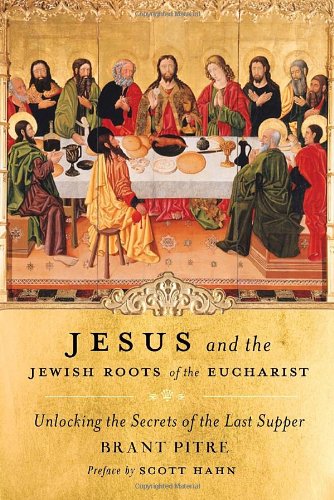Book review: Jesus and the Jewish Roots of the Eucharist
by Brant Pitre
★★★★★
Ever wonder how the Eucharistic teachings of the New Testament evolved? Where did Jesus get the idea for his Last Supper ritual? How did Paul think to tie this ritual to his theology of atonement? Why does John’s Gospel emphasize so strongly the Paschal Lamb? Why were the church fathers so adamant about tying the Eucharist to the Passover?
Because the Sacraments have deep Hebrew roots. I have studied a little about the pagan influences on the ceremony of bread and wine, this concept of “eating the body” and “drinking the blood,” but never delved much into its Hebrew side … other than to imagine how bizarre it must have appeared to God-fearing Jews, who had been taught since childhood never to ingest blood. Pitre digs into scripture and Judaic writings, and his research is fresh, scholarly, and easy to digest. If I can find more Pitre books, I’m going to snap them up.
Absolutely fascinating, and critical to Pitre’s conclusion, is a chapter in his book about the “shewbread” (showbread), what Pitre calls the “Bread of the Presence.” This bread, kept fresh in the Holy of Holies at the back of the Temple, shares a table with the libation flask, and thus links to the wine offering. Judaism has long connected the bread and the wine, back to the days of the very first priest, Melchizedek. But this holy bread carries with it a certain symbolism, understood by every Jew each time it was carried out for their viewing at the major festivals. Jesus references this “Bread of the Presence” (the presence of God, if you haven’t already guessed) directly in the Gospels, and it forms an important basis for understanding Jesus’ teaching at the Last Supper.
One interesting conclusion Pitre reaches is that Jesus never finished the Passover meal with his disciples! The fourth and final cup of wine, which each participating Jew shared during the Passover celebration, was never drunk. Instead, Jesus drank this final cup just moments before his death. Pitre thus brings the theological meaning of Jesus’ timing to life in a most intriguing way.
Pitre writes from a conservative Catholic perspective, as seems appropriate. (I’m no scholar of current-day religious practices, but who finds more ritualistic meaning in the Eucharist than the Catholics?) He does lean toward a Roman Catholic understanding of the bread and wine, though he avoids the word “transubstantiation” in favor of the baggage-free phrase “reality of Jesus’ presence in the Eucharist.” But I guarantee Christians of all denominations will enjoy this one.












 354 Circles
354 Circles
 603 Goodreads Friends & Fans
603 Goodreads Friends & Fans

 Hello! I'm an author, historical Jesus scholar, book reviewer, and liberal Christian, which means I appreciate and attempt to exercise the humanitarian teachings of Jesus without getting hung up on any particular supernatural or religious beliefs.
The Bible is a magnificent book that has inspired and spiritually fed generations for thousands of years, and each new century seems to bring a deeper understanding of life’s purpose. This is true of not only Christianity; through the years, our age-old religions are slowly transforming from superstitious rituals into humanitarian philosophies. In short, we are growing up, and I am thrilled to be riding the wave.
I avidly read all thought-provoking religion titles. New authors: I'd love to read and review your book!
Hello! I'm an author, historical Jesus scholar, book reviewer, and liberal Christian, which means I appreciate and attempt to exercise the humanitarian teachings of Jesus without getting hung up on any particular supernatural or religious beliefs.
The Bible is a magnificent book that has inspired and spiritually fed generations for thousands of years, and each new century seems to bring a deeper understanding of life’s purpose. This is true of not only Christianity; through the years, our age-old religions are slowly transforming from superstitious rituals into humanitarian philosophies. In short, we are growing up, and I am thrilled to be riding the wave.
I avidly read all thought-provoking religion titles. New authors: I'd love to read and review your book!
 Hi! While Lee writes the articles and reviews the books, I edit, organize, and maintain the blog. The views expressed here are Lee's but I'm his biggest supporter! :-)
Hi! While Lee writes the articles and reviews the books, I edit, organize, and maintain the blog. The views expressed here are Lee's but I'm his biggest supporter! :-)
Connect With Me!